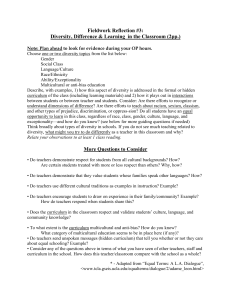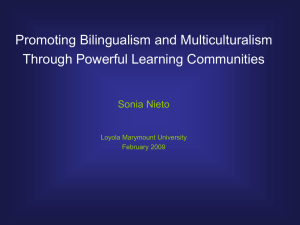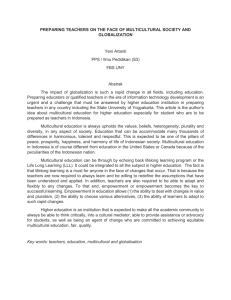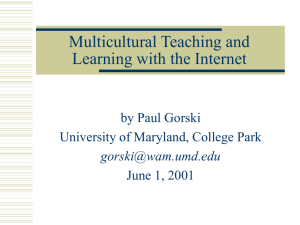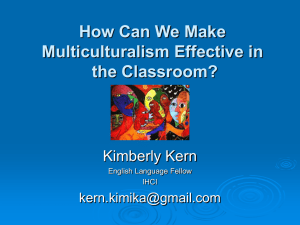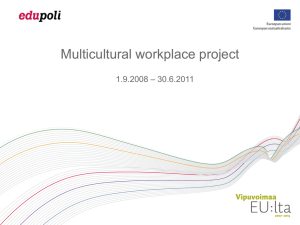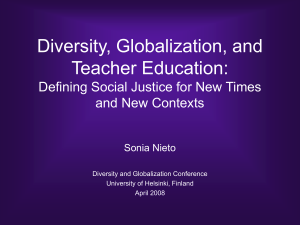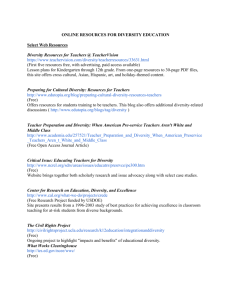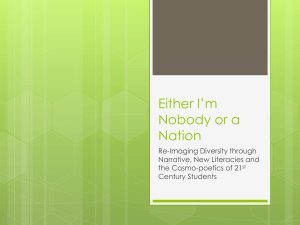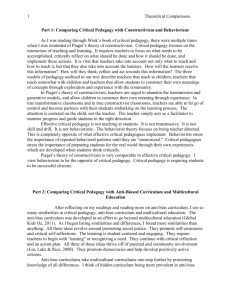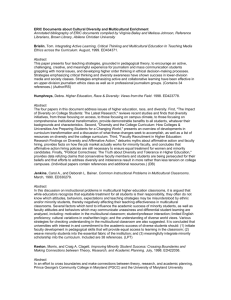SoniaNietoTalkApril6
advertisement
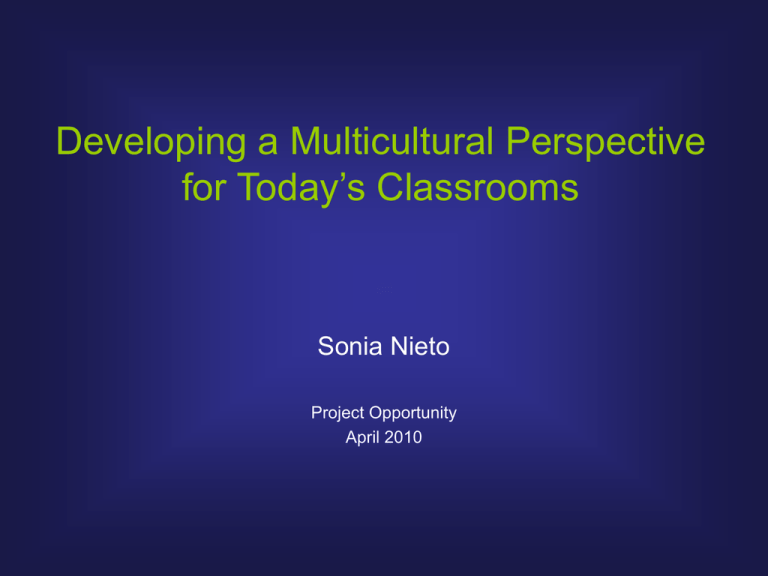
Developing a Multicultural Perspective for Today’s Classrooms Sonia Nieto Project Opportunity April 2010 the achievement gap “Culturally deprived children” - 1960s QuickTime™ and a TIFF(Uncompressed) dec ompress or are needed to see thi s pic ture. We are dealing, it would seem, not so much with culturally deprived children as with culturally depriving schools. And the task to be accomplished is not to revise, amend, and repair deficient children, but to alter and transform the atmosphere and operations of the schools to which we commit these children. William Ryan, Blaming the Victim (1972) Challenging the “deficit Perspective” and reframing the discourse • “at-risk students” • “sped kids • “non-English speaking” • “crack babies” • “achievement gap” • “risk-producing environments’ • “children with special needs” • “Vietnamese-speaking”, or “children becoming bilingual” • “babies born addicted to crack” • “resource gap” or “caring gap” Resource Gap Caring Gap • school financing • physical plant • computers and books • enriching curricular activities • extracurricular activities • teachers • teachers’ lack of knowledge and preparation for working with diverse populations • shortage of teachers of diverse backgrounds • teachers who want to teach in schools like they attended • structural inequality, racism, and classism • school funding and resources available in schools • school location • teacher experience and education • school preparedness and commitment to teach students different from themselves • etc. Framework for developing a multicultural perspective for today’s classrooms Sociopolitical context of schools and society (institutional/ ideological) Sociocultural knowledge and understandings Personal values and commitments Sociopolitical context • Societal level: – Who counts? • Who has access to education? health care? employment? housing? • Who can speak their native language in the community? at work? – What counts? • Whose language is “standard”? • Whose lifestyle is “normal”? • School level: – How do school policies and practices benefit some students over others? (curriculum, pedagogy, disciplinary policies, hiring practices, parent outreach, etc.) – Ex, Curriculum: Whose knowledge counts? • What knowledge does the curriculum reflect? • Whose perspective is represented? • Who benefits? Who loses? SOCIOCULTURAL knowledge and understandings • Who are the students in our classrooms and schools? • What experiences, talents, strengths, and resources do they bring to their education? – – – – What cultural resources do they have? What languages do they speak? What resources do their parents/families have? What resources are available in their communities? • How can I use students’ personal talents and strengths and family and community “funds of knowledge” in the curriculum? PERSONAL VALUES AND COMMITMENTS • Understanding that racism, classism, sexism, and other biases are all around us • Examining our own commitments, values, and biases • Doing something about it Quality EDUCATION for all students = Access Equity Asking “profoundly “profoundly multicultural multicultural questions”: questions” Asking • Who’s taking calculus? physics? Are there enough labs for all students? • Is the bilingual (ESL, ELL, or special education) program in the basement? (hall closet?under the stairway? next to the boiler?) • What are our children worth? • Who’s teaching the children? BECOMING A TRUE MULTICULTURAL EDUCATOR • Identity, difference, power, and privilege are all connected • Multicultural education is inclusive of many differences • Education is always political; it cannot be separated from the sociopolitical context in which it exists • Teachers are not the villains (neither are principals or superintendents) because structural issues matter a great deal, but teachers and other educators take responsibility for holding high expectations for all students Characteristics of Multicultural Education • Anti-racist/anti-bias education • Basic education • Important for all students/people • Pervasive • A process • Education for social justice • Critical pedagogy Anti-racist, anti-bias education Confronts racism and other biases directly through content, approaches, and pedagogy: Not simply celebratory: it welcomes “dangerous discourse” Teaches young people skills in combating bias Pays attention to how some students benefit over others in school policies and practices Basic Education • As necessary as reading, writing, arithmetic, and computer literacy • Part of the core curriculum • A more representative, more truthful canon • Preparation for living in an increasingly diverse, complex, and interconnected world Important for all students • Not just for “urban,” “minority,” “at risk,” “disadvantaged” students • All students have been miseducated, although in different ways Pervasive • Not a specific subject matter, unit, class, or teacher • Not just ethnic tidbits, holidays, festivals, or fairs A philosophy; a way of thinking about the world education for social justice • • Challenges, confronts, and disrupts untruths, misconceptions, and stereotypes Provides all students with the resources necessary to become fully human and to learn to their full potential (both material and emotional) education for social justice • • Draws on students’ resources, talents, and strengths, and “funds of knowledge” (González & Moll, 2005) Creates a learning environment that promotes critical thinking and agency for social change A Process • Beyond curriculum and materials, textbooks and units • Dynamic, ongoing, ever-changing • Involves intangibles Relationships o Communication o Critical pedagogy • Recognizes that knowledge is neither neutral nor apolitical and that every educational decision is a political decision • Teaches students to question, explore and critique • Helps teachers and students understand different perspectives • Helps students and teachers move beyond their partial (and therefore) limited experiences • Not about “political correctness,” but about affirmation and respect for all students of all backgrounds Being effective teachers in today’s classrooms • Learn about your students • Become a sociocultural mediator • Expect the best from students • Teach students to be critical learners • Understand that teaching is advocacy Learn about your students to connect with families Mary Cowhey: “You write about reading the class. I guess I jump the gun. Part of how I address my fear about the first day of school is to face it, as you suggest…” Learn About your students to develop relationships Yahaira Marquez: “I appreciate the relationships I’ve developed with many of my students. Having students look up to me as not only their English teacher, but as a mentor when they need one, has allowed me to see them as whole people…” Become a Sociocultural mediator • Encourage families to use native languages at home: reading, writing, speaking, and listening • Encourage students to retain ethnic ties • Develop an authentically cultural/ multicultural curriculum Become a sociocultural mediator Mary Ginley: “I'm a White, middleclass woman who grew up in a White, middleclass neighborhood and went to a White middle-class college. I knew if I was really going to teach today’s kids, I had a lot to learn.” Being nice is not enough “Every child needs to feel welcome, to feel comfortable. School is a foreign land to most kids (where else in the world would you spend time circling answers and filling in the blanks?), but the more distant a child’s culture and language are from the culture and language of the school, the more at risk that child is. A warm friendly, helpful teacher is nice but it isn’t enough… Expect the best from students • High standards need to be accompanied by high expectations • Low expectations get in the way of achievement • Rashaud Kates: “Being an African American student, to me, really it’s kinda tense…” Expect the best from students I hope to become the kind of teacher whose trust and faith in his students translate into unwavering expectations… I used to believe it was enough for my students to discover and trust their own voice, to write at a level and style that pleased them. Seth Peterson Teach Students to be Critical Learners “I say that reading is not just to walk on the words, and it is not flying over the words either. Reading is re-writing what we are reading” Paulo Freire Teach Students to be Critical • Teach students to probe, to be curious, and to question. • Ron Morris: “I like history the way Seymour teaches it… it’s like the reading is so real. The message here is just so powerful. Instead of just reading, we discuss…” Understand that teaching is advocacy for social and political change • What’s the content of the curriculum? Who’s included? Who’s left out? (Freire: “Who benefits? Who loses?”) • Who are the teachers, counselors, administrators? What experience, expertise, and commitment do they have? • Are families welcomed into the school? Who’s included? Who’s left out? • What kinds of extracurricular choices are available for students? Are all students included? • Are students encouraged to be active and critical learners?
